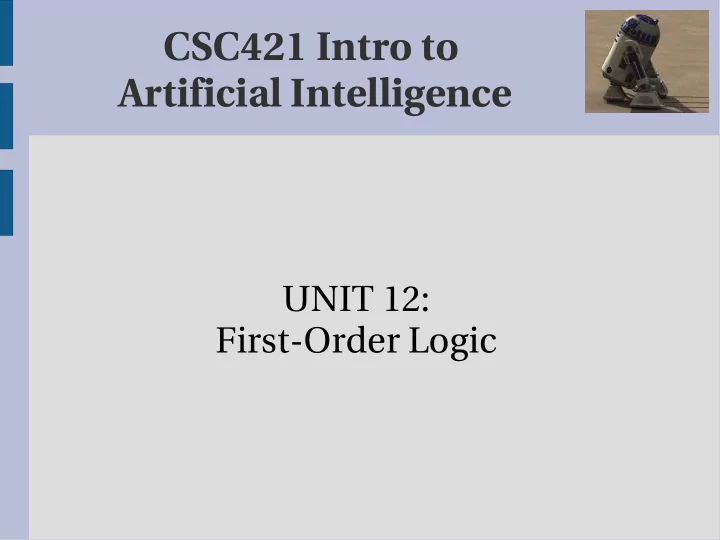

CSC421 Intro to Artificial Intelligence UNIT 12: First-Order Logic
Using FOL ● Assertions ● Queries or goals ● Substitution or binding list ● Axioms ● Theorems (entailed by axioms) ● Should a KB only contain axioms ?
Interacting with FOL KBs ● Suppose a wumpus-world agent is using a FOL KB and perceives a smell and a breeze (but no glitter) at t = 5. – Tell(KB, Percept([Smell, Breeze, None], 5)) – Ask(KB, ∃ a Action(a, 5)) – i.e does KB entail any particular action at t = 5 ● Answer: yes, {a/Shoot} - substitution – Binding list – Typically what we really want is the substitution for which there is an answer not just yes/no
Substitutions ● Given a sentence S and a substitution σ S σ denotes the result of plugging σ into S ● For example – S = Smarter(x,y) – σ = {x/Foo, y/Bar} – S σ = Smarter(Foo,Bar) ● ASK(KB, S) returns some/all σ such that KB |= S σ
KB for the Wumpus world ● “Perception” – ∀ b,g,t Percept([Smell, b,g], t) => Smell(t) – ∀ s,b,t Percept([s, b,Glitter], t) => AtGold(t) ● “Reflex” – ∀ t AtGold(t) => Action(Grab, t) ● “Reflex with internal state” – ∀ t AtGold(t) ∧ ¬ Holding(Gold, t) => Action (Grab,t) ● Holding(Gold, t) can not be observed => keeping track of change is essential
Deducing Hidden Properties ● Properties of locations: – ∀ x,t At(Agent,x,t) ∧ Smelt(t) => Smelly(x) – ∀ x,t At(Agent,x,t) ∧ Breeze(t) => Breezy(x) ● Squares are breezy near a pit: – Diagnostic rule – infer cause from effect ● ∀ y Breezy(y) => ∃ x Pit(x) ∧ Adjacent(x,y) – Causal rule – infer effect from cause ● ∀ x,y Pit(x) ∧ Adjacent(x,y) => Breezy(y) – Neither of these is complete – e.g. The causal rul e doesn't say whether squares away from pits can be breezy – Definition of Breezy Predicate: ● ∀ y Breezy(y) <=> ∃ x Pit(x) ∧ Adjacent(x,y)
Knowledge Engineering ● Identify task ● Assemble relevant knowledge ● Decide on a vocabulary on predicates, functions and constants ● Encode general information about the domain ● Encode a description of the specific problem instance – “Disembodied” knowledge vs sensors ● Pose queries to inference procedure ● Debug KB
Circuits I ● Composed of wires and gaes ● Signals flow along wires to the input terminals of gates, and each gate produces signal on the output terminal that flow along another wire. AND, OR, XOR, NOT ● Modeling depends on what you want – Functionality and connectivity – Faulty circuits (inlcude wires in ontology) – Timing faults (include gate delays)
Circuits II ● Decide on vocabulary ● Gates – Distinguish gate from other gates (X1,X2...) – Type(X1) = XOR (use function) – Alternatively Type(X1,XOR) or XOR(X1) ● Terminals – In(1, X1) ● Connectivity – Connected(Out(1,X1), In(1,X2)) ● Signal on/off – 1, 0
Encode General Knowledge of the domain ● If two terminals are connected, they have same signal – ∀ t1, t2 Connected(t1, t2) => Signal(t1) = Signal(t2) ● The signal at every terminal is either 1 or 0 (but not both) – ∀ t Signal(t) = 1 ∨ Signal(t) = 0 1 ≠ 0 ● Connected is commutative ● OR gate ouput is 1 iff any of it's inputs is 1 – ∀ g Type(g) = OR => Signal(Out(1,g)) = 1 <=> ∃ n Signal(In(n,g)) = 1 ● AND similarly ● XOR ● NOT
Encode specific problem instance ● Gates – Type(X1) = XOR Type(X2) = XOR – Type(A1) = AND Type(A2) = AND – Type(O1) = OR ● Connections: – Connected(Out(1,X1), In(1,X2)) – Connected(Out(1,X1), In(2, A2)) – Connected(Out(1,A2), In(1,O1)) – .. – .. –
Pose queries to inference procedure ● What combinations of inputs would cause the output of C1 to be 0 and the second output of C1 (the carry bit) to be 1 – Answers: Substitutions for variables ● What are the possible sets of values of all the terminals in the adder circuit ? – Complete input-ouput table for device – Simple example of circuit verification ● Stuctured knowledge-base development
Recommend
More recommend